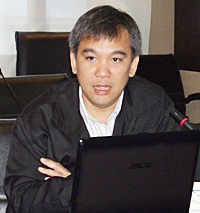Consultants working on a joint Pattaya / Provincial Electricity Authority project to build the area’s first waste-to-energy plant are getting closer to a decision whether the incinerator project should go forward.
At another update session Oct. 8, Doldej Tangtrakarnpong, director of Naraesuan University’s environmental center, said researchers have determined that only new garbage would be suitable for burning.

Doldej Tangtrakarnpong, director of Naraesuan University’s environmental center, says researchers have determined that only new garbage would be suitable for burning.
Doldej said the feasibility study looks at three types of trash: fresh garbage, solid waste less than three years old, and solid waste older than three years. It was found that only the fresh garbage and solid waste of less than 3 years can produce electricity because both have similar energy potentials and better particles as fuel for energy production.
Solid waste older than three years, he said, has fewer particles for fuel and more non-degradable objects remaining than these other two types of solid waste.
He estimated all studies and research will be completed by December.
The PEA selected Pattaya in January as the site of a pilot project for its first waste-to-energy plant. The utility has spent the past months on the feasibility of locating the plant in the Khao Miakaew Sub-district. The previous update was in June.
Pattaya produces up to 400 tons of garbage a day, second only to Bangkok. City officials have said that as the city grows in popularity, so does its trash problem. With insufficient space to continue building landfills, another solution was needed.
PEA executives estimate up to 400 mw of power could be generated by burning non-recyclable portions of all the garbage produced daily in Thailand.




